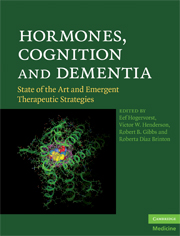Book contents
- Hormones, Cognition and Dementia
- Hormones, Cognition and Dementia
- Copyright page
- Contents
- Contributors
- Preface
- Section 1 Estrogens and cognition: perspectives and opportunities in the wake of the Women's Health Initiative Memory Study
- Section 2 Varieties of estrogenic therapy
- Chapter 7 Alternative estrogenic treatment regimens and the Kronos Early Estrogen Prevention Study – Cognitive and Affective substudy (KEEPS-CA)
- Chapter 8 The use of transdermal 17β-estradiol in the treatment of Alzheimer's disease
- Chapter 9 Alternative modes of treatment: pulsatile estradiol treatment
- Chapter 10 In search of estrogen alternatives for the brain
- Section 3 Potential modulators and modifiers of estrogenic effects
- Section 4 Possible genetic factors related to hormone treatment effects
- Section 5 Testosterone, estradiol and men, and sex hormone binding globulin
- Section 6 Gonadotropin effects
- Index
- Plate Section
Chapter 7 - Alternative estrogenic treatment regimens and the Kronos Early Estrogen Prevention Study – Cognitive and Affective substudy (KEEPS-CA)
from Section 2 - Varieties of estrogenic therapy
Published online by Cambridge University Press: 06 July 2010
- Hormones, Cognition and Dementia
- Hormones, Cognition and Dementia
- Copyright page
- Contents
- Contributors
- Preface
- Section 1 Estrogens and cognition: perspectives and opportunities in the wake of the Women's Health Initiative Memory Study
- Section 2 Varieties of estrogenic therapy
- Chapter 7 Alternative estrogenic treatment regimens and the Kronos Early Estrogen Prevention Study – Cognitive and Affective substudy (KEEPS-CA)
- Chapter 8 The use of transdermal 17β-estradiol in the treatment of Alzheimer's disease
- Chapter 9 Alternative modes of treatment: pulsatile estradiol treatment
- Chapter 10 In search of estrogen alternatives for the brain
- Section 3 Potential modulators and modifiers of estrogenic effects
- Section 4 Possible genetic factors related to hormone treatment effects
- Section 5 Testosterone, estradiol and men, and sex hormone binding globulin
- Section 6 Gonadotropin effects
- Index
- Plate Section
Summary
Few comparisons of the efficacy of different estrogenic formulations on brain function have been carried out. While most basic science studies have evaluated effects of estradiol, many of the clinical studies that have evaluated effects of hormone therapies (HT) in healthy older women have used conjugated equine estrogens (CEE). In this chapter, Gleason, Wharton, Carlsson, and Asthana review some of the cellular mechanisms by which estrogens are thought to protect the brain from age-related cognitive decline and Alzheimer's disease (AD), and discuss the pros and cons of oral vs. transdermal therapies and of estradiol vs. CEE. Their analysis identifies numerous advantages of transdermal estradiol vs. oral estrogenic therapies, primarily related to effects on liver enzymes, venus thromboembolic events, and inflammatory cytokines. Collectively, the analysis provides compelling arguments in favor of transdermal estradiol as the therapy of choice. Nevertheless, it is clear that the benefits of estradiol vs. CEE have yet to be proven, as has the efficacy of estrogenic therapies (ET) in the prevention of AD. These issues will be addressed in the recently initiated Kronos Early Estrogen Prevention Study (KEEPS) trial and the ancillary KEEPS study of cognitive aging. Details of the trial including its design and primary goals are discussed.
- Type
- Chapter
- Information
- Hormones, Cognition and DementiaState of the Art and Emergent Therapeutic Strategies, pp. 65 - 79Publisher: Cambridge University PressPrint publication year: 2009

